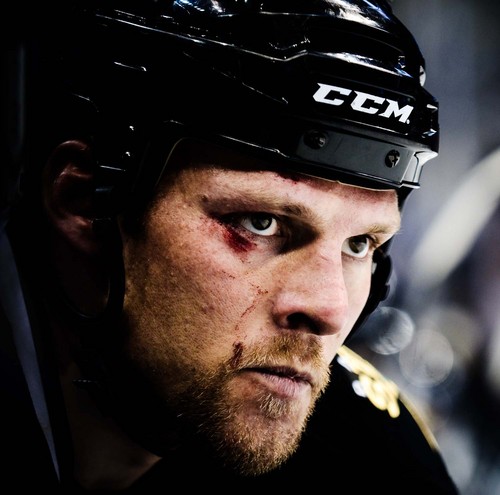
By Avi Goldberg, Special to All Habs Hockey Magazine
MONTREAL, QC. — There has been a fair amount of debate surrounding the Krys Barch Twitter rant from last Saturday night and whether there was any big picture significance to the thoughts of a marginal NHL player. Judging from the media coverage of the incident, in which the analysis has mostly alternated between slim and scathing, skepticism reigns. Taking Barch’s marginal status a little more seriously, however, provides an opening for deeper interpretation. Since people on the margins of social contexts have vantage points of their surroundings that are not as available to everyone else, I would say that the Barch comments do contain some important observations that are worthy of further discussion.
 The most obvious significance of Barch’s Twitter talk pertains to the NHL labour negotiation.
The most obvious significance of Barch’s Twitter talk pertains to the NHL labour negotiation.
Collective negotiations between two sides in a dispute require that both parties demonstrate solidarity to the public and to each other. The recent Jimmy Devellano diatribe against the players not only showed the challenge of keeping members of a group in line but also that the owners appear to be steadfastly united in their resolve to resist the players’ claims.
While the fine levied against Devellano provides evidence that Gary Bettman wields a heavy hand in keeping the owners quiet, Donald Fehr’s efforts to forge a new culture of unity among the players has also been noted. We know that many of the owners have the means to wait things out, but in going rogue, Barch alerts us to the potential that exists for more economically marginal groups of players to speak out against the defined interests of the NHLPA should the cost of lost income become too hard for them to bear.
Beyond lockout politics, a second insight arises from asking what the Barch comments might reveal about the particular anxieties of players like him in today’s NHL.
In referring to the pain his body has endured, his consumption of alcohol, his concern for his ability to provide for his growing family, and in his insinuation that the owners are taking away his ability to do the job he loves, Barch’s pleas put health, safety, and existential threats to hockey’s enforcers on uncomfortable public display. Not withstanding the influence of alcohol, what would lead him to want to do that?
To establish his credibility, Barch made explicit linkages between the work experiences of hockey fighters and those of other blue collar workers. While this comparison aims to draw empathy by highlighting the especially wide gaps in privilege that separate the fourth line hockey players from the owners, it may also have been delivered as way to publicly rationalize the on and off-ice stresses and coping strategies that distinguish hockey enforcers from their more widely serviceable teammates and union brethren.
Interpreting Barch’s remarks as expressing a pre-emptive effort to normalize his hockey job does not require logic to be stretched too far. With acceptance of the fighter’s role as valuable in today’s NHL not nearly as secure as it used to be, in addition to losing their income, enforcers are hovering in a perceived position of weakness.
A final insight relates to the role of new media in the current version of the lockout.
Is digital media allowing fans to exert leverage on the hockey negotiators in the same manner as protesters are believed to have used online networking to gain new opportunities to shape domestic politics during the Arab Spring? Or, can the potentials for rapid and wide dissemination of player sentiment on the internet be harnessed to push the league into compromises that it otherwise would not have felt pressure to make? Does Barch’s Twitter commentary, and its immediate repercussions, yield any tentative answers?
Getting ordinary people to leave their routines to act in support of a cause requires more than just anger. Without leadership, strategy, incentives, peer pressure, prominent allies, and meaningful bonds between would be foot soldiers, the translation of anger into effective action usually does not occur. Had the tweets been written by Sidney Crosby or Claude Giroux, and had they been accompanied by a call for fans to take coordinated action against the NHL, perhaps a new media mobilization potential could have been initiated. Because they were authored by a relatively marginal hockey figure, with limited public prestige and influence, they have had little traction. They can be classified as nothing more than one digital narrative of complaint among many others.
Digital media are currently providing opportunities for fans to communicate with each other about their frustrations and to independently express their individual opinions about the lockout. Conditions can change, but despite recent claims to the contrary, the deepening of this digital interaction is currently containing the anger to the blogosphere and the twitterverse rather than channelling it in opposition to its perceived source.
Krys Barch was understandably taken to task for tweeting that fans should empathize with athletes who risk losing the potential to continue to earn millions of dollars a year, but our inability to relate to his claims of economic vulnerability is not the only message here. Seeing him as a player whose specific hockey job may be on the line, and who publicly vented his fears through a communications medium whose independent power to wield influence can easily be exaggerated, Barch’s tweets may signal the anxiety he feels about his ability to control his own life as much as they reveal his anger over the owners’ refusal to agree to the players’ terms for concluding a new CBA.
Follow me on Twitter @AviGoldberg